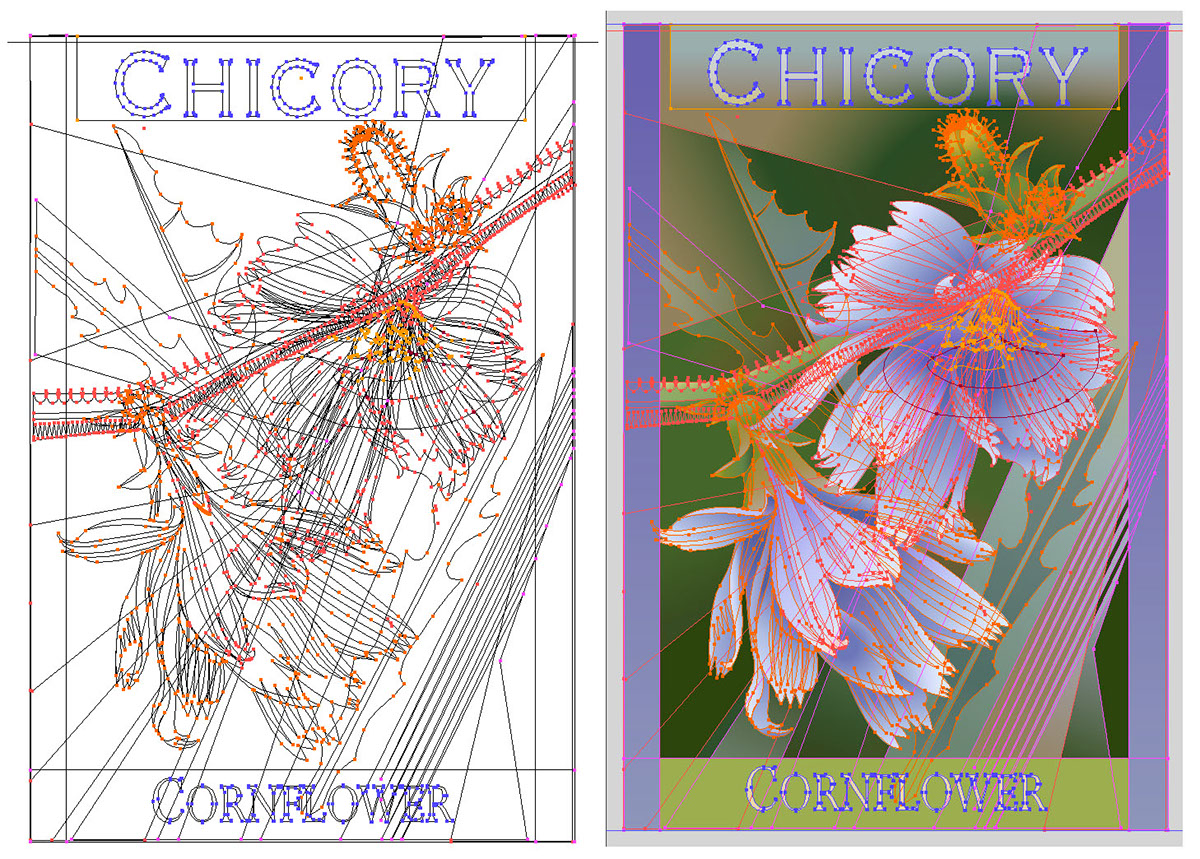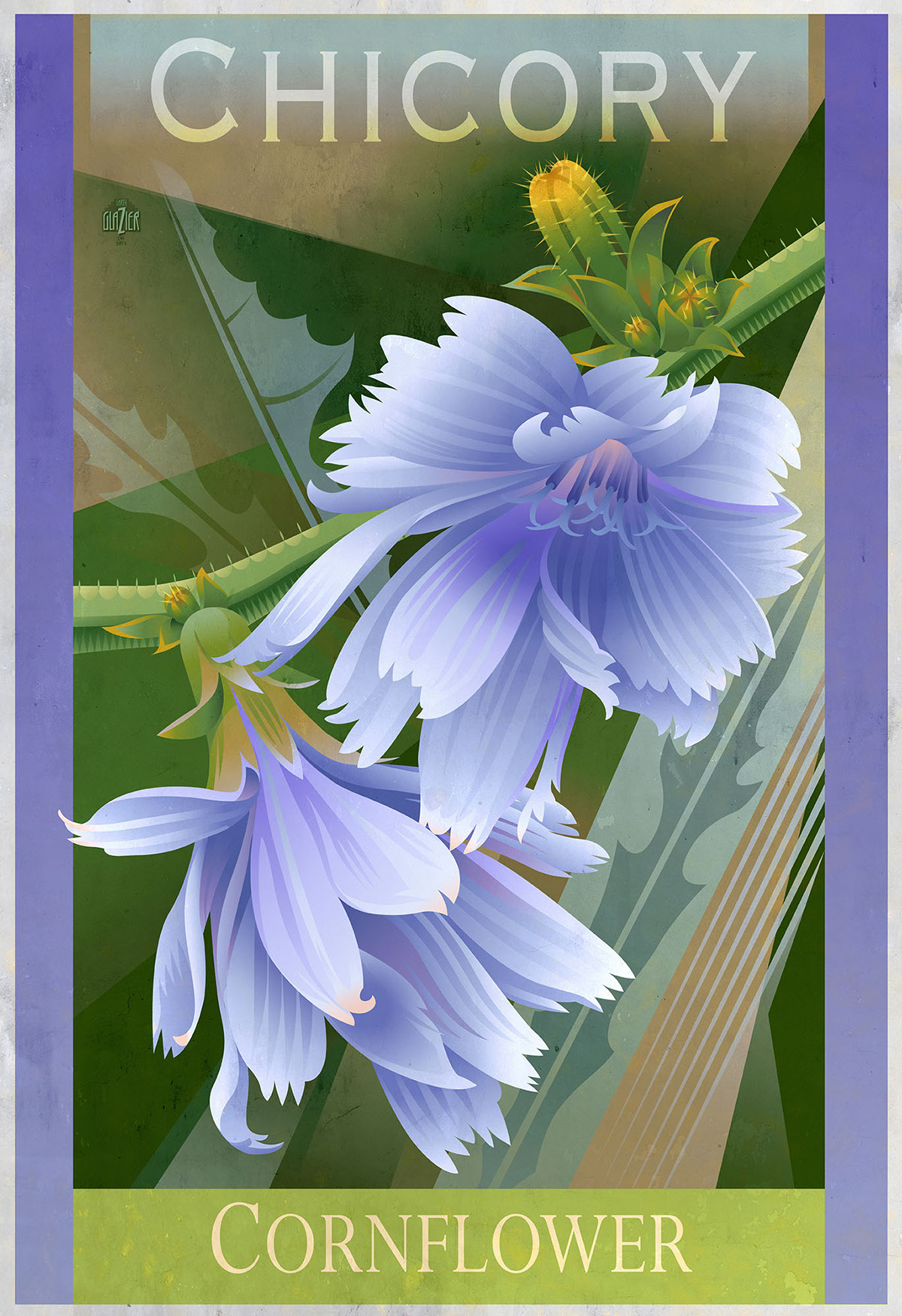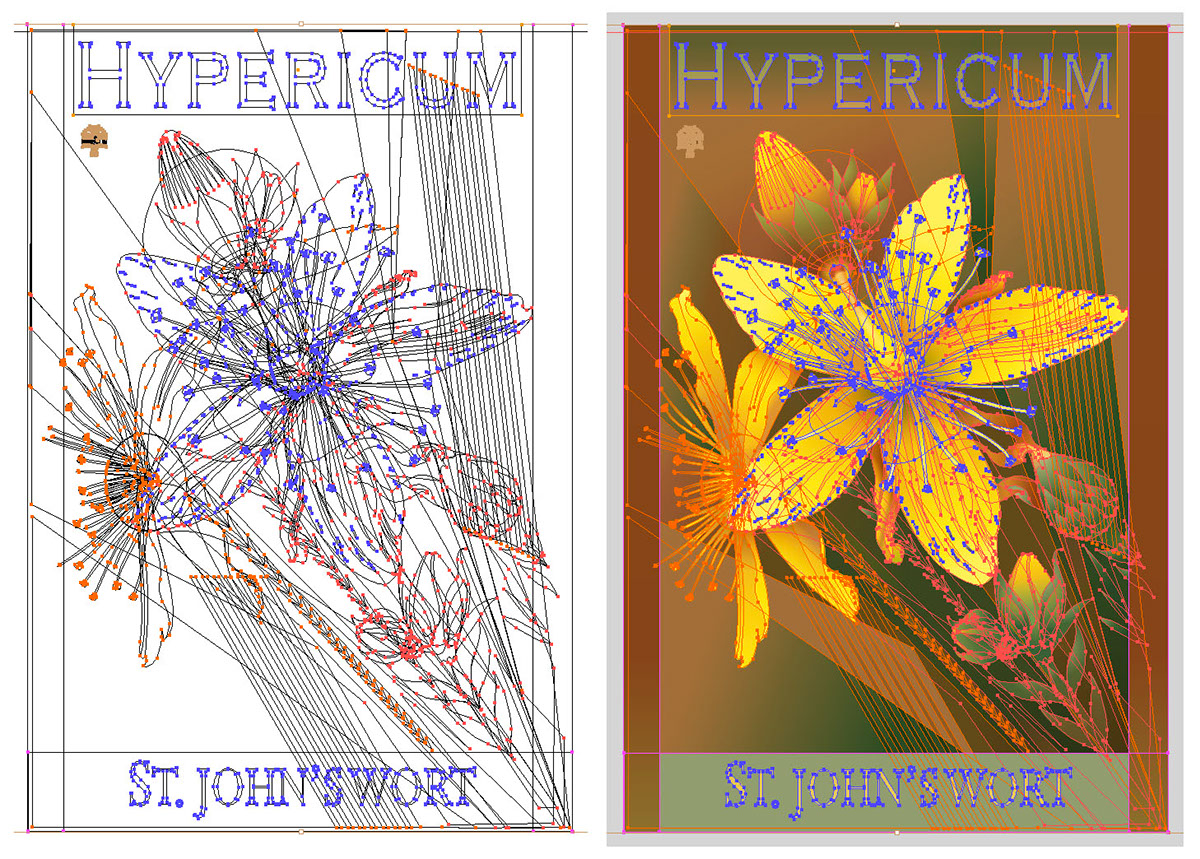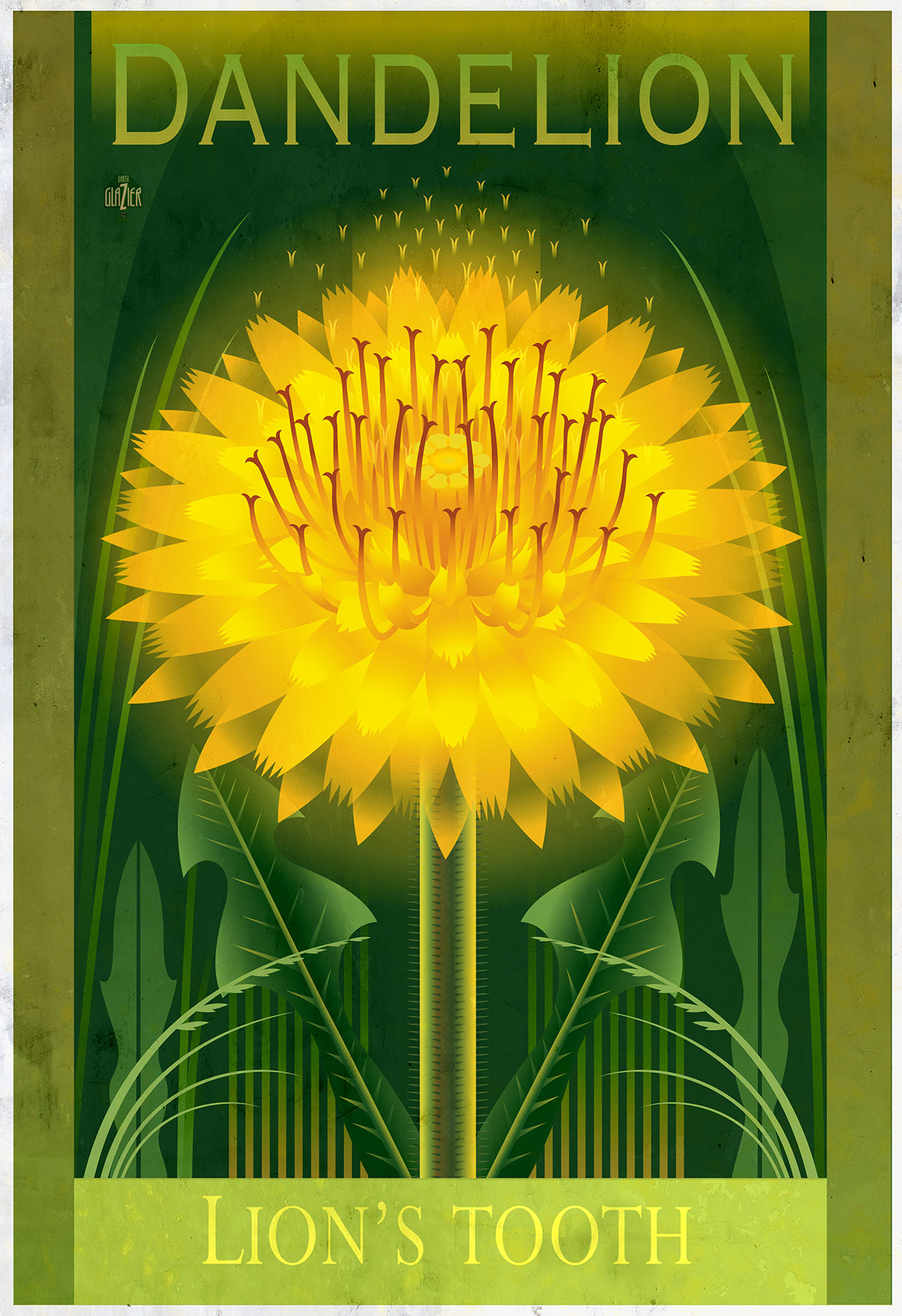MEADOWLANDS: BOTANICAL GRAPHICS
I am creating a series of posters and print patterns for fabric using common invasive weeds/wildflowers by illustrating their inherent beauty. Two years ago I took photos of a meadow along a busy major avenue. This patch of green was filled with native and invasive flowers reaching the peak of their bloom. A week later they mowed everything down, but not before I found some real treasures in these delicate humble flowers.
Each plant has medicinal benefits and/or value to agriculture and the environment.
***
View my website portfolio at GarthGlazierArts.com
Work also viewable at the Directory of Illustration
Buy Prints on Fine Art America

BUCKHORN
Also known as Plantain, this common invasive weed is edible and can be used in salads.
MedIcinal Uses From:
www.greenmedinfo.com/blog/medicinal-properties-plantain
"The leaves as well as the juice have been widely used as topical substances in poultices and lotions for treating sunburns, stings, insect bites, snakebites, poison ivy breakouts, rashes, burns, blisters, and cuts. Furthermore, the leaves have also been heated and applied topically to swollen joints, sore muscles, sprains, and sore feet. Interestingly enough, Plantain is a common folk remedy in many part of Latin America for treating cancer. It has also been used for many centuries in treating sore throats, coughs, bronchitis, tuberculosis, and mouth sores. Studies have shown that plantain has anti-inflammatory effects." http://www.greenmedinfo.com/blog/medicinal-properties-plantai

Wireframe


QUEEN ANNE'S LACE
Also known as Wild Carrot, the root is edible when young. Queen Anne's Lace is considered a beneficial plant in pastures helping to aid digestion of horses and cows.
MedIcinal Uses From:
www.localharvest.org/queen-annes-lace-tea-bulk-dried-herb-C18321
"Medicinal Properties and Uses of Queen Anne's Lace: Queen Anne's lace (wild carrot) is a diuretic, helps in soothing the digestive tract and stimulates the uterus in helping to promote menstruation, it's seeds often called (the morning after herb). Queen Anne's Lace as a tea, helps to stop the formation of kidney stones, used as a treatment for hangovers, stimulate the flow of urine and waste of kidneys and aid in the treatment of diabetes. Supports the liver and helps with bladder diseases. It's properties consist of: Abortifacient, antiseptic, Antibacterial, astringent, Carminative, diuretic, Deobstruent, emmenagogue, stimulant, anthelmintic, carminative, mildvermifuge." http://www.localharvest.org/queen-annes-lace-tea-bulk-dried-herb-C18321

Wireframe


CHICORY
Also known as Cornflower. I don't see as many of these as I did when I was a kid, but Chicory has been hybridized into a number of deep blue colored varieties for the flower garden. It is related to Radicchio. I remember it growing in the hard clay soil behind the house where I grew up.
MedIcinal Uses From:
www.botanical.com/botanical/mgmh/c/chicor61.html
www.botanical.com/botanical/mgmh/c/chicor61.html
"The fresh root is bitter, with a milky juice which is somewhat aperient and slightly sedative, suiting subjects troubled with bilious torpor, whilst, on good authority, the plant has been pronounced useful against pulmonary consumption. A decoction of 1 OZ. of the root to a pint of boiling water, taken freely, has been found effective in jaundice, liver enlargements, gout and rheumatic complaints, and a decoction of the plant, fresh gathered, has been recommended for gravel. Syrup of Succory is an excellent laxative for children, as it acts without irritation. An infusion of the herb is useful for skin eruptions connected with gout.The old herbalists considered that the leaves when bruised made a good poultice for swellings, inflammations and inflamed eyes, and that 'when boiled in broth for those that have hot, weak and feeble stomachs doe strengthen the same.' Tusser (1573) considered it - together with Endive - a useful remedy for ague, and Parkinson pronounced Succory to be a 'fine, cleansing, jovial plant.'" http://www.botanical.com/botanical/mgmh/c/chicor61.html

Wireframe


ST. JOHN'S WORT
Also known as Hypericum, this hardy plant is a major force in the food suppliments industry.
MedIcinal Uses From:
www.ncbi.nlm.nih.gov/books/NBK92750/
www.ncbi.nlm.nih.gov/books/NBK92750/
"The use of this species as an herbal remedy to treat a variety of internal and external ailments dates back to the time of the ancient Greeks. Since then, it has remained a popular treatment for anxiety, depression, cuts, and burns. Recent research suggests the effectiveness of this herb in treating other ailments, including cancer, inflammation-related disorders, and bacterial and viral diseases, and as an antioxidant and neuroprotective agent. Pharmaceutical companies, particularly in Europe, prepare standard formulations of this herb that are taken by millions of people. Worldwide annual sales of products made from SJW presently exceed several billion dollars." http://www.ncbi.nlm.nih.gov/books/NBK92750/

Wireframe


WILD ROSE, Rose Hips
My latest in the series, I am sticking with plants that have edible or medicinal uses. This design is based on Rosa Canina.
MedIcinal Uses From:
www.vegetarian-nutrition.info/herbs/rose-hips.php
www.vegetarian-nutrition.info/herbs/rose-hips.php
"The anti-inflammatory properties of rose hips have recently been shown to be useful in the treatment of patients suffering from knee or hip osteoarthritis. Osteoarthritis is a degenerative joint disease affecting over 20 million Americans. It is characterized by the breakdown of cartilage in the joint, allowing bones to rub against each other, causing pain and loss of movement." http://www.vegetarian-nutrition.info/herbs/rose-hips.php
"There are many culinary uses for rose hips. They can be used fresh, dried, or preserved. Rose hips can be used in apple sauce, soups and stews, syrups, puddings, marmalade, tarts, breads, and pie, or made into a jam or jelly. Each hip comprises an outer fleshy layer which may contain up to 150 seeds embedded in a matrix of fine hairs. The irritating hairs should be removed before using the rose hips in a recipe." http://www.vegetarian-nutrition.info/herbs/rose-hips.php

Wireframe


DANDELION, Lion's Tooth
It is that time of year for the appearance of the annual dandelion bonanza. So I thought this image should be next my botanical series. This illustration moves closer to the Plantain in style with more geometric segmentation.
Medicinal Uses From:
Dandelion | University of Maryland Medical Center
"While many people think of the dandelion (Taraxacum officinale) as a pesky weed, it's chock full of vitamins A, B, C, and D, as well as minerals such as iron, potassium, and zinc. Dandelion leaves are used to add flavor to salads, sandwiches, and teas. The roots are used in some coffee substitutes, and the flowers are used to make wines.
In the past, dandelion roots and leaves were used to treat liver problems. Native Americans also boiled dandelion in water and took it to treat kidney disease, swelling, skin problems, heartburn, and upset stomach. In traditional Chinese medicine, dandelion has been used to treat stomach problems, appendicitis, and breast problems, such as inflammation or lack of milk flow. In Europe, dandelion was used in remedies for fever, boils, eye problems, diabetes, and diarrhea."
Source: Dandelion | University of Maryland Medical Center http://umm.edu/health/medical/altmed/herb/dandelion#ixzz3i2lATQfL
University of Maryland Medical Center
Follow us: @UMMC on Twitter | MedCenter on Facebook

Wireframe


Buy Prints on Fine Art America


